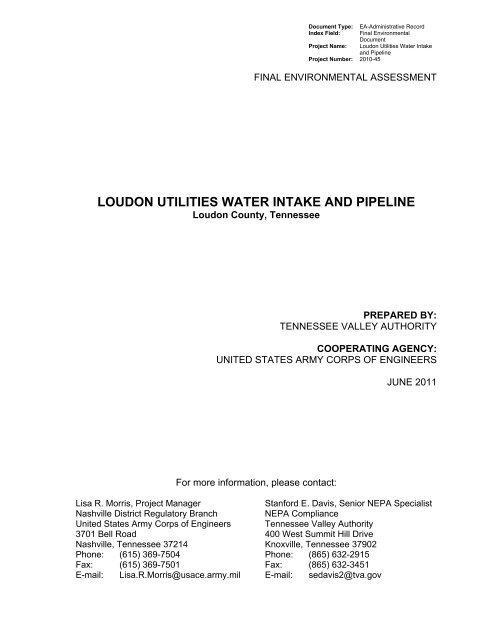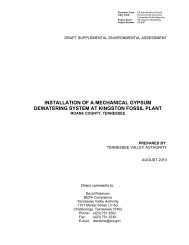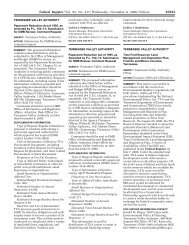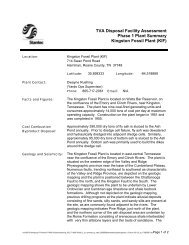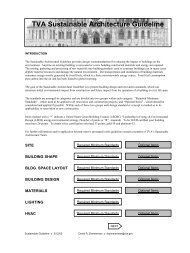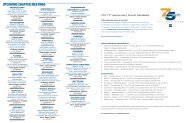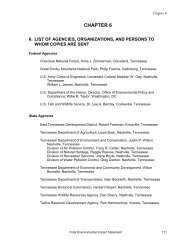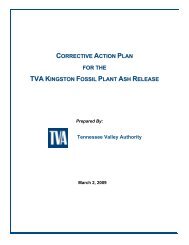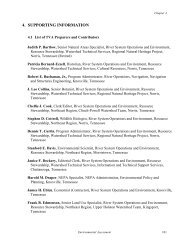Environmental Assessment - Tennessee Valley Authority
Environmental Assessment - Tennessee Valley Authority
Environmental Assessment - Tennessee Valley Authority
Create successful ePaper yourself
Turn your PDF publications into a flip-book with our unique Google optimized e-Paper software.
Document Type: EA-Administrative Record<br />
Index Field: Final <strong>Environmental</strong><br />
Document<br />
Project Name: Loudon Utilities Water Intake<br />
and Pipeline<br />
Project Number: 2010-45<br />
FINAL ENVIRONMENTAL ASSESSMENT<br />
LOUDON UTILITIES WATER INTAKE AND PIPELINE<br />
Loudon County, <strong>Tennessee</strong><br />
PREPARED BY:<br />
TENNESSEE VALLEY AUTHORITY<br />
COOPERATING AGENCY:<br />
UNITED STATES ARMY CORPS OF ENGINEERS<br />
JUNE 2011<br />
For more information, please contact:<br />
Lisa R. Morris, Project Manager<br />
Stanford E. Davis, Senior NEPA Specialist<br />
Nashville District Regulatory Branch<br />
NEPA Compliance<br />
United States Army Corps of Engineers <strong>Tennessee</strong> <strong>Valley</strong> <strong>Authority</strong><br />
3701 Bell Road 400 West Summit Hill Drive<br />
Nashville, <strong>Tennessee</strong> 37214 Knoxville, <strong>Tennessee</strong> 37902<br />
Phone: (615) 369-7504 Phone: (865) 632-2915<br />
Fax: (615) 369-7501 Fax: (865) 632-3451<br />
E-mail: Lisa.R.Morris@usace.army.mil E-mail: sedavis2@tva.gov
Page intentionally blank
FINAL ENVIRONMENTAL ASSESSMENT<br />
LOUDON UTILITIES WATER INTAKE AND PIPELINE<br />
LOUDON COUNTY, TENNESSEE<br />
TENNESSEE VALLEY AUTHORITY<br />
MAY 2011<br />
The Proposed Decision and Need<br />
Loudon Utilities Board (LUB) proposes to construct a new raw water intake structure and<br />
intake pipe and a river crossing to replace a water line that was previously hung on the old<br />
United States Highway (US) 11 bridge (see Attachment A). These improvements are part<br />
of a project to expand the existing facilities at the Loudon Utilities Water Treatment Plant<br />
(WTP).<br />
The WTP currently has a capacity of 14.0 million gallons per day (MGD). The expansion<br />
would increase this capacity to 20.0 MGD. The WTP supplies potable water to the cities of<br />
Loudon and Philadelphia, in Loudon County, <strong>Tennessee</strong>. According to LUB, peak water<br />
demands at the WTP have reached 95 percent of the current permitted capacity.<br />
The proposed finished water pipeline river crossing would replace the water line that was<br />
previously attached to the old State Route 2/US 11 bridge. The water main would provide<br />
necessary water to residential, commercial, and industrial customers on the east side of the<br />
river. Currently, there are no other alternatives that eliminate the need to cross the<br />
<strong>Tennessee</strong> River. The current demand for water on the east side of the river continues to<br />
increase, and the new highway bridge is not capable of supporting a 24-inch-diameter<br />
water line.<br />
Background<br />
On October 8, 2008, LUB applied for Section 26a permits for a three-phase improvement<br />
project to increase and improve potable water service to residents and businesses in<br />
Loudon County. The first phase of this project was to provide maintenance for the raw<br />
water intake and water line at the WTP at <strong>Tennessee</strong> River Mile (TRM) 592.3 leftdescending<br />
bank (L). Due to erosion along the riverbank, a 16-inch-diameter water main<br />
crossing the river had become exposed and was in need of immediate stabilization.<br />
Because of the expedient nature of the situation, <strong>Tennessee</strong> <strong>Valley</strong> <strong>Authority</strong> (TVA)<br />
approved the installation of approximately 200 tons of riprap and the removal of<br />
approximately 200 cubic yards of silt and sediment (see Attachment B, Categorical<br />
Exclusion Checklist 19649 and TVA Section 26a approval dated March 24, 2009).<br />
The second phase includes construction of a new raw water intake structure and piping to<br />
increase the water intake capacity from 14 MGD to 20 MGD. The new intake piping would<br />
extend into the river approximately 500 linear feet with 48-inch-diameter ball and socket<br />
jointed iron piping. The piping would be properly anchored to the river bottom and when<br />
necessary installed below grade. Raw water would be drawn through five 27-inch-diameter<br />
screens, with a maximum screen opening of 0.25 inch. Initially, only four screens would be<br />
installed with a fifth reserved for future build out. In addition, there would be five 6-inchdiameter<br />
compressed air lines connected to each of the screens for cleaning.<br />
1
The third phase is a 24-inch-diameter finished water line crossing the <strong>Tennessee</strong> River at<br />
TRM 591.6L (see Figure 1). The river crossing is being proposed to replace the former<br />
water line that was on the old US 11 bridge, which was demolished and replaced in 2003.<br />
The new US 11 bridge is not capable of supporting a 24-inch water line. The water line<br />
would be trenched 3 feet deep, down each bank to elevation 721 feet and properly<br />
anchored to the river bottom for the remainder of the crossing. The top of all anchors would<br />
be below 721 feet elevation. The pipe used in the river crossing would consist of Class 250<br />
cement-lined ductile iron ball joint pipe. The pipe is designed to provide a deflection angle<br />
of 15 degrees.<br />
Section 26a of the <strong>Tennessee</strong> <strong>Valley</strong> <strong>Authority</strong> Act, requires that TVA approval be obtained<br />
prior to the construction, operation, or maintenance of a structure or construction activity<br />
affecting navigation, flood control, or public lands. Therefore TVA’s action would be to<br />
make a decision on the Section 26a approval request for the construction of a new 20-MGD<br />
water intake and 48-inch raw water pipeline at the Loudon Utilities WTP and crossing of the<br />
<strong>Tennessee</strong> River by a 24-inch-diameter water line under Section 26a of the TVA Act. To<br />
address the potential environmental impacts of the proposal, TVA has agreed to be the lead<br />
agency cooperating with the United States Army Corps of Engineers (USACE) in the<br />
preparation of this environmental assessment (EA). USACE’s action would be to approve<br />
the project under Section 10 of the Rivers and Harbors Act and Section 404 of the Clean<br />
Water Act.<br />
Other <strong>Environmental</strong> Reviews and Documentation<br />
Categorical Exclusion Checklist Number 19649 (TVA 2009b)<br />
On March 13, 2009, TVA completed an environmental review and approved Phase 1 of the<br />
proposed LUB water intake and pipeline project to repair and maintain the existing water<br />
pipeline and intake (see Attachment B).<br />
Section 26a Approval for <strong>Tennessee</strong> State Route 2 (US 11) Bridge Over the <strong>Tennessee</strong><br />
River <strong>Environmental</strong> <strong>Assessment</strong> and Finding of No Significant Impact (FONSI) (TVA 2002)<br />
In April 2002, TVA completed an EA and FONSI for the replacement of the US 11 bridge<br />
over the <strong>Tennessee</strong> River at TRM 591.6 near Loudon, <strong>Tennessee</strong>. Under the Preferred<br />
Alternative to construct a new bridge, there was the potential to kill or harm individuals of<br />
the endangered pink mucket and orangefoot pimpleback mussels. Commitments and<br />
additional requirements from the United States Fish and Wildlife Service (USFWS) revised<br />
biological opinion (BO) reduced all impacts to the aquatic animals to insignificant levels. In<br />
addition, a memorandum of agreement between the <strong>Tennessee</strong> State Historic Preservation<br />
Officer (SHPO), the <strong>Tennessee</strong> Department of Transportation, Federal Highway<br />
Administration, <strong>Tennessee</strong> Department of Environment and Conservation (TDEC), and the<br />
Eastern Band of the Cherokee Indians ensured the recovery and preservation of any<br />
archaeological information from an archaeological site that would be adversely affected by<br />
the proposed project. The bridge has been successfully constructed with the application of<br />
the conditions and mitigation and is currently in service.<br />
2
Figure 1.<br />
Map of Vicinity and Proposed Water Line<br />
3
Alternatives and Comparison<br />
Scoping by TVA has determined that from the standpoint of the National <strong>Environmental</strong><br />
Policy Act (NEPA), there are two viable alternatives available: the No Action Alternative<br />
and the Proposed Action Alternative With Special Conditions. The original Action<br />
Alternative proposed by the applicant did not contain special conditions necessary to<br />
mitigate impacts to aquatic species and is no longer considered feasible.<br />
The No Action Alternative<br />
The No Action Alternative would result in the denial or withdrawal of the applicant’s request<br />
for a Section 26a approval for construction of the new water intake and finished water line<br />
across the reservoir. This alternative would not meet the needs of the applicant.<br />
Action Alternative – The Proposed Action Alternative With Special Conditions<br />
Under the Action Alternative, TVA would issue a Section 26a approval for a 20-MGD water<br />
intake and a finished water line across the <strong>Tennessee</strong> River near the US 11 bridge.<br />
However, the applicant would implement best management practices (BMPs), standard and<br />
special conditions to minimize or reduce the environmental effects of the proposed project<br />
to levels of insignificance or mitigation to offset adverse project impacts.<br />
Affected Environment and Evaluation of Impacts<br />
Site Description<br />
The proposed LUB project is in Loudon County, <strong>Tennessee</strong>, on Watts Bar Reservoir. Watts<br />
Bar Dam and Lock are about 62 miles downstream, and the Fort Loudoun Dam and Lock<br />
are about 10 miles upstream. The <strong>Tennessee</strong> River is over 1,000 feet wide in this area and<br />
ranges from 8 to 35 feet deep. TVA maintains a 9-foot-deep navigation channel. The area<br />
of Watts Bar Reservoir surrounding the proposed project is influenced by various activities<br />
and features, including commercial river navigation, recreational boating, private land use,<br />
municipal water use and wastewater treatment, agriculture (primarily pasturelands),<br />
forested areas, roads, and industry (food product manufacturers and ethanol production).<br />
The proposed project, along with the existing water intake and treatment plant, is located in<br />
the Ridge and <strong>Valley</strong> ecoregion of East <strong>Tennessee</strong>. In this area, the <strong>Tennessee</strong> River<br />
flows between parallel low rolling hills and valleys. Much of the underlying bedrock is<br />
limestone and dolomite, leading to a karst topography. The city of Loudon is located<br />
adjacent to the proposed project on the west side of the <strong>Tennessee</strong> River with the US 11<br />
bridge downstream and the WTP about a mile upstream (see Figure 1). The river is broad<br />
in appearance at the bridge and water intake site, but the presence of a large island just<br />
downstream of the bridge restricts navigation to a narrow channel on the left-descending<br />
(Loudon city) side of the river. A city park and homes have been built along the leftdescending<br />
bank between the WTP and proposed pipeline crossing. The right-descending<br />
side of the river includes several industrial sites and agricultural land. The riverbanks<br />
outside the city of Loudon are mostly forested, with openings for fields and homes.<br />
Impacts Evaluated<br />
The applicant’s proposed activities subsequent to TVA’s selection of the Action Alternative<br />
would have no impact to natural features, such as terrestrial endangered species; wetlands;<br />
prime or unique farmland; groundwater; unique or important terrestrial plant and wildlife<br />
habitats; recreation; parks or natural areas; visual resources; socioeconomics;<br />
environmental justice; air quality; noise; transportation; solid waste; and Wild and Scenic<br />
Rivers, or contribute to the spread of exotic or invasive species.<br />
4
Resources that could be affected by the proposed action have been given further<br />
consideration in this EA and include floodplains, threatened and endangered aquatic<br />
species, cultural resources, commercial navigation, aquatic ecology and water quality, and<br />
water withdrawal.<br />
Floodplains<br />
Construction of the intake and pipeline would occur within the limits of the 100-year<br />
floodplain. Consistent with Executive Order 11988, TVA has determined that there is no<br />
practical alternative to the proposal other than to site it in the floodplain. From the<br />
standpoint of flood control, TVA has determined that the proposed action would not result in<br />
adverse impacts provided the following conditions are included in the permit:<br />
implementation of construction BMPs and applicable TVA General and Standard<br />
Conditions.<br />
Threatened and Endangered Aquatic Species<br />
Two federally listed as endangered mussel species (orangefoot pimpleback and pink<br />
mucket) and one federally listed as threatened fish species (snail darter) have been<br />
reported within 10 river miles of the proposed project, downstream of Fort Loudoun Dam<br />
(Table 1). Additionally, one state-listed mussel species and two fish species are also<br />
known from this area (Table 1). No federally designated critical habitat (DCH) is present<br />
near the project area. According to a November 21, 1997, letter from McKinney<br />
(<strong>Tennessee</strong> Wildlife Resources Agency [TWRA]) to Brisson (<strong>Tennessee</strong> Department of<br />
Transportation [TDOT]), the most recent survey near the proposed project (at US 11 bridge)<br />
found three live pink mucket mussels, which equated to about 2.7 percent of the total<br />
mussels collected (USFWS 2011); see Attachment C.<br />
A 2011 revised biological assessment (BA) prepared by CCR <strong>Environmental</strong>, recognized<br />
that the pink mucket, orangefoot pimpleback, and snail darter could potentially be impacted<br />
by the proposed project (see Attachment D). The USFWS BO concurred (see attachment<br />
C) that these species likely occur within the project’s action area.<br />
Table 1. Federally and State-Listed Aquatic Species Known Within 10 River Miles<br />
of the Loudon Utilities Project 1<br />
Common Name<br />
Scientific Name<br />
State Status 2<br />
(Rank) 3<br />
Federal<br />
Status 3<br />
Fish<br />
Flame chub Hemitremia flammea NMGT (S3) -<br />
Snail darter Percina tanasi THR (S2S3) THR<br />
Tangerine darter Percina aurantiaca NMGT (S3) -<br />
Mussels<br />
Orangefoot pimpleback 4 Plethobasus cooperianus END (S1) END<br />
Pink mucket Lampsilis abrupta END (S2) END<br />
<strong>Tennessee</strong> clubshell 3 Pleurobema oviforme TRKD (S2S3) -<br />
1 Source: TVA Natural Heritage database; records upstream of Fort Loudoun and Tellico dams were omitted<br />
due to barrier effects and significant change in habitat conditions by dams.<br />
2 Status Codes: END = Endangered; NMGT = In need of management; THR = Threatened; TRKD = Tracked<br />
as sensitive, but has no legal status<br />
3 State Ranks: S1 = Critically imperiled; S2 = Imperiled; S3 = Vulnerable; S#S# = Occurrence numbers are<br />
uncertain<br />
4 Historical = Database records are ≥25 years old.<br />
5
A brief description of species potentially occurring near the project can be found below.<br />
Biology and habitat requirements are described in Etnier and Starnes (1993) and<br />
NatureServe (2011) for fish and in Parmalee and Bogan (1998) for mussels.<br />
Flame Chub: An inhabitant of springs and spring runs, the flame chub, usually occurs in<br />
areas of lush aquatic vegetation. It occurs in the <strong>Tennessee</strong> River drainage from the<br />
Knoxville area downstream through the Mud Creek system south of Savannah (Hardin<br />
County), <strong>Tennessee</strong>. The species also occurs in the upper Duck River and in the middle<br />
Cumberland drainage, primarily in the upper Caney Fork system. Habitat for flame chub is<br />
not expected to occur within impact areas of the proposed project in Watts Bar Reservoir;<br />
therefore, this species is not considered further in this EA.<br />
Snail Darter: This species occurs in deeper portions of rivers and reservoirs where current<br />
is present. The snail darter spawns from February to mid-May through August. Larvae drift<br />
downstream into deeper, lower-velocity areas. In late summer, the juveniles migrate<br />
upstream to shoal areas where they spawn. Snail darter larvae and juveniles may occur<br />
within the project impact area.<br />
Tangerine Darter: The tangerine darter inhabits clearer portions of large to moderate-sized<br />
headwater tributaries of the <strong>Tennessee</strong> River. It frequents deeper riffles and runs with<br />
boulders, large rubble, and bedrock most of the year but moves into deeper pools in winter.<br />
It is confined to the upper <strong>Tennessee</strong> River drainage and reaches maximum abundance in<br />
smaller tributaries such as the Emory, Little Emory, Little Pigeon, Tellico, and Hiwassee<br />
rivers. Habitat for tangerine darter is not expected to occur within impact areas of the<br />
proposed project in Watts Bar Reservoir; therefore, this species is not considered further in<br />
this assessment.<br />
Orangefoot Pimpleback: This species inhabits medium to large rivers in moderate current<br />
in sand, gravel, and/or cobble substrate often in deeper water. Historical records are<br />
known to occur within a 10-mile radius of the proposed project area. The USFWS issued a<br />
2007 Final Rule to reintroduce experimental populations in the lower French Broad and<br />
lower Holston rivers. As recognized in the 2011 BA and BO associated with this project,<br />
orangefoot pimpleback is believed to occur within the project impact area in very low<br />
numbers. However, the USFWS BO concluded that, given the extremely rare occurrence<br />
of orangefoot pimpleback and nature of potential indirect impacts from the proposed<br />
project, the level of impacts to this species would not rise to the level of “take.” Therefore,<br />
orangefoot pimpleback is not considered further in this EA.<br />
Pink Mucket: Typically, a big river species, the pink mucket occasionally becomes<br />
established in small to medium-sized tributaries of large rivers. It generally inhabits rocky to<br />
sand/gravel substrates with swift current, usually in less than 3 feet of water; however, it<br />
has been found living and reproducing in reservoir habitat containing adequate flow.<br />
Suitable habitat occurs near the project, and it is believed to inhabit the project impact area<br />
in low densities (CCR <strong>Environmental</strong> 2011; USFWS 2011).<br />
<strong>Tennessee</strong> Clubshell: This species occurs in the <strong>Tennessee</strong> and Cumberland rivers’<br />
drainages. The <strong>Tennessee</strong> clubshell prefers substrate of coarse gravel and sand in small,<br />
shallow creeks and rivers with good current. Spawning likely takes place in spring, and<br />
larvae are expelled during summer, with several fish species shown to serve as<br />
reproductive hosts. The project impact area does not likely support appropriate habitat for<br />
<strong>Tennessee</strong> clubshell; therefore, this species is not evaluated further in this assessment.<br />
6
No Action Alternative - Under the No Action Alternative, no changes to environmental<br />
conditions would occur; thus, no impacts to threatened or endangered species within the<br />
project area would occur.<br />
Action Alternative With Modification - Under the Action Alternative, TVA would approve<br />
construction and operation of a 20-MGD water intake at TRM 592.3L and a water line<br />
across the <strong>Tennessee</strong> River at TRM 591.6 with implementation of the mitigative measures<br />
of the BA to minimize or reduce the environmental effects of the proposed project to<br />
federally listed aquatic species (Attachment D), as well as the reasonable and prudent<br />
measures and supporting terms and conditions, along with stipulations and requirements,<br />
provided in the USFWS BO (Attachment C).<br />
The BA (CCR <strong>Environmental</strong> 2011) and BO evaluated potential project impacts to federally<br />
listed aquatic species and determined that the project was likely to adversely affect the pink<br />
mucket (federally listed as endangered) and snail darter (federally listed as threatened).<br />
Although the USFWS (2011) believed that the orangefoot pimpleback was likely to occur in<br />
the project action area, it determined that the extremely rare occurrence of this species, in<br />
combination with the project methods and conservation measures, would result in project<br />
effects that were not likely to reach a level of take. Therefore, the action agencies and<br />
USFWS agree that the proposed project is not likely to adversely affect orangefoot<br />
pimpleback. All of the agencies also agreed that no DCH for any of the three federally<br />
listed aquatic species would be adversely modified or destroyed since no DCH was present<br />
in the action area for the project. Based on the project description and conservation<br />
measures, size of the project’s action area, nature of the project’s impacts on the aquatic<br />
habitat, and status of the pink mucket and snail darter in the action area, the USFWS<br />
estimated that 45 pink muckets and six snail darters would be incidentally taken (in the form<br />
of harassment, harm, and/or death) by the construction and operation of the proposed<br />
project within the action area. Lastly, the USFWS determined that incidental take of the<br />
pink mucket and snail darter by the project was not likely to jeopardize the continued<br />
existence of these two species.<br />
The BA (CCR <strong>Environmental</strong> 2011) and the BO (USFWS 2011) provided detailed analyses<br />
on the likely effects to the pink mucket and orangefoot pimpleback from the proposed<br />
project. In summary, direct effects would include:<br />
1. Increased turbidity during instream construction activities would compel snail darters<br />
and fish that serve as hosts for pink mucket to relocate to less suitable habitat<br />
outside of the action area.<br />
2. Increased turbidity and/or deposition of sediment during instream construction would<br />
interfere with the respiration, feeding, and reproduction activities of pink mucket, as<br />
well as clog fish gills and reduce feeding and growth in larval snail darters.<br />
3. Physical injury or death of pink mucket from dredging and placement of the finished<br />
water pipeline, finished water line anchors, raw water intake structure, raw water<br />
intake screen anchor, and raw water pipeline on the stream bottom.<br />
4. Mortality of snail darter and pink mucket larvae from impingement against the intake<br />
screens or passing through the screens and becoming entrained within the intake<br />
structure.<br />
7
A summary of indirect effects from the project on federally listed species, which were<br />
detailed in the BA and BO, includes the following:<br />
1. Changes in hydraulics and riverbed substrate would dislodge and induce stress on<br />
adult and/or juvenile pink mucket mussels. Stress to listed mussels could result in<br />
decreased ability to respire, reproduce, and feed.<br />
2. Adverse impacts, including mortality, to pink muckets and snail darters from<br />
pollutants (petroleum and hydraulic fluids) entering the river during project<br />
construction; impacts to water quality could affect respiration, feeding, and<br />
reproduction capabilities of adults and juveniles of both pink mucket and snail<br />
darters.<br />
Cultural Resources<br />
East <strong>Tennessee</strong> has been an area of human occupation for the last 12,000 years. This<br />
includes five broad cultural periods: Paleo-Indian (11,000-8,000 B.C.), Archaic (8000-1600<br />
B.C.), Woodland (1600 B.C.-A.D. 1000), Mississippian (A.D. 1000-1700), and Historic (A.D.<br />
1700-present). Prehistoric land use and settlement patterns varied during each period, but<br />
short- and long-term habitation sites were generally located on floodplains and alluvial<br />
terraces along rivers and tributaries. Specialized campsites tended to be located on older<br />
alluvial terraces and in the uplands. In East <strong>Tennessee</strong>, during the 17th and 18th centuries,<br />
Europeans and Native Americans began interacting through the fur trading industry.<br />
European-American settlement increased in the early 19th century as the Cherokee were<br />
forced to give up their land.<br />
On June 2, 1870, Loudon County was established from parts of Roane, Monroe, and Blount<br />
counties. No major battles were fought in the area that became Loudon County during the<br />
Civil War; however, the Loudon bridge across the <strong>Tennessee</strong> River was an important link<br />
between Knoxville and Chattanooga. Following the Civil War, industrialization slowly<br />
developed in the county. The creation of Fort Loudoun Reservoir in the 1940s and Tellico<br />
Reservoir in the 1970s, along with the residential community Tellico Village, contributed<br />
significantly to the local economy (Spence 1998).<br />
The archaeological area of potential effect (APE) for the project was determined to be all<br />
areas where ground disturbance would occur, which includes the proposed 9,500 feet of<br />
24-inch pipeline and the proposed location of the new intake/pump station. The APE for<br />
architectural resources includes a 0.5-mile area surrounding the proposed new intake/pump<br />
station, as well as any areas where the project would alter existing topography or<br />
vegetation in view of a historic resource. A preliminary records search was conducted prior<br />
to the survey and identified two previously recorded archaeological resources (40LD0013<br />
and 40LD0032) within the APE. Both of these sites are prehistoric. Existing roads and<br />
utility lines are running through both sites, and the proposed pipeline would be placed into<br />
the existing disturbed road rights-of-way and utility trenches. Two previously recorded<br />
architectural resources (Blair’s Ferry Storehouse and Dunbar Public School) were identified<br />
within the APE. A Phase I cultural resources survey was conducted during Fall 2010<br />
(Susano and Guymon 2011). No previously unrecorded archaeological resources and 21<br />
previously unrecorded architectural resources (LD-TVA 01- 21) were identified within the<br />
APE.<br />
8
No Action Alternative - Under the No Action Alternative, the water intake and pipeline would<br />
not be constructed and no historic properties currently listed or eligible for listing in the<br />
National Register of Historic Places (NRHP) would be affected.<br />
Action Alternative With Modification - Under the Action Alternative, the proposed pipeline<br />
would be placed into the existing disturbed road rights-of-way and utility trenches, and the<br />
undertaking would not affect intact archaeological deposits in the two prehistoric sites<br />
(40LD0013 and 40LD0032). Both the Blair’s Ferry Storehouse and the Dunbar Public<br />
School are listed in the NRHP, and neither has a direct line of sight to the proposed<br />
intake/pump station. The 21 previously unrecorded architectural resources (LD-TVA 01-21)<br />
are considered ineligible for listing in the NRHP. Therefore, under the Action Alternative, no<br />
historic properties that are listed or eligible for listing in the NRHP would be adversely<br />
affected by the proposed undertaking.<br />
Navigation<br />
This stretch of the <strong>Tennessee</strong> River has recreation and commercial traffic in the form of<br />
small recreational vessels and commercial barge tows. Over 1.2 million tons of commercial<br />
barge cargo moved on Watts Bar Reservoir in 2005 (TVA 2009a). Over 800,000 tons of<br />
this traffic either originated or terminated at the four active commercial barge terminals<br />
located on Watts Bar Reservoir. On the average, 200-250 barge tows per year transport<br />
such commodities as grains and grain products, iron and steel, minerals, asphalt, sand,<br />
salt, and fertilizers. In 2006, 1,800 to 1,900 recreational vessels locked through at Watts<br />
Bar and Fort Loudoun dams.<br />
The LUB pipeline for the proposed new raw water intake structure and submarine crossing<br />
would be assembled in sections (approximately 80 feet in length) on shore. Each section<br />
would be hoisted by a barge-mounted crane into the river, sunk, and moved into position<br />
and anchored by divers. This process would be repeated for each section until the entire<br />
pipeline is in place and secured. Potentially, during construction, these activities could<br />
temporarily and on an intermittent basis interfere with recreational and commercial traffic<br />
near the US 11 bridge and at the proposed intake site at the WTP.<br />
Tate and Lyle, a grain processing facility, is on the north shore of the reservoir across from<br />
the proposed water intake site. This facility has an operating barge terminal for offloading<br />
grain.<br />
The approximately 500-foot-long, 48-inch-diameter ball joint ductile iron pipe extending to<br />
the new water intake would be buried below the river bottom when the existing river bottom<br />
elevation is greater than 721 feet above mean sea level (msl). When the river bottom<br />
elevation is less than 721 feet above msl, the pipe would be anchored to the river bottom<br />
through the use of concrete anchors. The pipe would be strapped down to the anchors.<br />
LUB would also install a new 24-inch water main from the existing WTP to Blair Bend Drive.<br />
The proposed route would begin on Grove Street, proceed north to the intersection of Main<br />
Street, then cross Watts Bar Reservoir/<strong>Tennessee</strong> River (near TRM 591.6), and intersect<br />
Blair Bend Drive. The finished water line would be trenched down each bank to below<br />
elevation 721 feet and properly secured using concrete anchors to the river bottom. The<br />
top of all anchors and pipe would be below 721 feet elevation. The length of pipe crossing<br />
the river would be approximately 1,300 feet.<br />
9
No Action Alternative - The water intake and pipeline would not be installed; consequently,<br />
there would be no impacts to navigation.<br />
Action Alternative With Modification - The TVA navigation guideline for submarine pipeline<br />
crossings in commercial navigation channels on mainstream rivers is that the top elevation<br />
of the pipe or anchors should not be less than 3 feet below channel bottom grade. Channel<br />
bottom grade in the area is 724 feet. The original plans provided by LUB did not meet TVA<br />
navigation guidelines for installing water intakes. Minor design changes were required to<br />
lower the elevation of the main run of the pipeline (see Attachment E). The top of the<br />
buried pipeline and anchors would emerge from the bank below elevation 721 feet above<br />
msl and extend out along the river bottom perpendicular to the shoreline. At the end of the<br />
pipeline, the top of the intake screens are proposed to be at elevation 720.83 feet above<br />
msl, or 3.17 feet below channel bottom grade. The proposed action meets the minimum<br />
depth requirements. Additionally, shoreline warning signage indicating the presence of<br />
submerged pipelines should be clearly visible and legible from the water.<br />
Due to the amount of commercial and recreational activity in this area, timely<br />
communication of in-water work activities and schedules is imperative to reduce impacts to<br />
navigation. All in-water work activities and schedules should be coordinated with the<br />
USACE Nashville District for inclusion in a Notice to Navigation Interests as soon as the<br />
information is available. LUB should follow USACE’s guidance to minimize impacts from<br />
potential navigational situations during construction of the facilities, such as potential delays<br />
or rerouting during construction. Therefore, with the Section 26a Permit contingent upon<br />
the special conditions described in the Mitigation section, any impacts to navigation would<br />
be temporary and minor.<br />
Aquatic Ecology and Water Quality<br />
The <strong>Tennessee</strong> River has been impounded at numerous locations, including Fort Loudoun<br />
Dam that occurs upstream of the proposed project and Watts Bar Dam downstream.<br />
Sedimentation from agricultural practices, residential, commercial, and industrial<br />
development in the Watts Bar watershed has adversely impacted the aquatic habitat in the<br />
area. TDEC has the project area listed on the state’s Clean Water Act Section 303(d) list<br />
as impaired due to contaminated sediments from polychlorinated biphenyls (PCBs) and low<br />
dissolved oxygen (DO) from releases at Fort Loudoun Dam (TDEC 2008). Watts Bar<br />
Reservoir also has a fish consumption advisory for numerous species due to PCBs.<br />
The construction of a new raw water intake structure and piping would affect an area of<br />
riverbed approximately 500 feet long and 9.5 feet wide from installation of a 48-inch pipe<br />
and water from the water column withdrawn through five 27-inch intake screens at TRM<br />
592.3L. The construction of a 1,300-foot-long 24-inch-diameter water line entrenched in the<br />
riverbed across the <strong>Tennessee</strong> River at TRM 591.6, within 100 feet upstream of the US 11<br />
bridge, would affect approximately 1,000 feet of the riverbed within a path of up to 6 feet<br />
wide. An additional 50 feet downstream from each structure is expected to be influenced<br />
by indirect effects such as sedimentation and changes in hydrology.<br />
Substrate within the project area is predominately sand, gravel, and cobble occurring in the<br />
“transition zone” of Watts Bar Reservoir. Various habitats within Watts Bar Reservoir (and<br />
others throughout the TVA system) are routinely evaluated using TVA’s Ecological Health<br />
Monitoring Program to monitor reservoir health. The program provides data for comparing<br />
future water quality conditions, and serves as a screening program for targeting more<br />
detailed studies if the need arises. The ecological health scoring system is based on five<br />
10
indicators: (1) DO; (2) chlorophyll, a measure of the amount of algae in the water;<br />
(3) sediment contaminants–PCBs, pesticides, and metals; (4) benthic macroinvertebrates;<br />
and (5) fish assemblage. Each indicator is evaluated separately, and then individual ratings<br />
are combined into a single, composite score for each reservoir. Reservoir Ecological<br />
Health Monitoring is one of five components of TVA’s overall river and reservoir monitoring<br />
effort, termed Vital Signs Monitoring. Other components of the monitoring program include:<br />
(1) examining ecological conditions in tributary streams to the <strong>Tennessee</strong> River;<br />
(2) monitoring toxic contaminants in fish flesh to determine their suitability for consumption;<br />
(3) evaluating the number and size of important game fish species to help ensure their<br />
populations remain abundant and robust; and (4) sampling bacteriological concentrations at<br />
recreational areas to evaluate their suitability for water contact with people.<br />
Fisheries Monitoring - Fish are included in Vital Signs Monitoring because they are<br />
important to the aquatic food chain and because they have a long life cycle that allows them<br />
to reflect water quality conditions over time. Fish are also important to the public for<br />
aesthetic, recreational, and commercial reasons. Ratings are based primarily on fish<br />
community structure and function using a metric known as the Reservoir Fish Assemblage<br />
Index (RFAI). Also considered in the rating is the percentage of the sample represented by<br />
omnivores and insectivores, overall number of fish collected, and the occurrence of fish with<br />
anomalies such as diseases, lesions, parasites, deformities, etc. (TVA 1999). Watts Bar<br />
Reservoir has been monitored on an annual basis from 2006 to 2010. Over the past five<br />
years, it has rated “good” or “fair” at all sites (Table 2).<br />
Table 2. Recent (2006-2010) RFAI Scores 1 on Watts Bar Reservoir Collected as Part<br />
of the Vital Signs Monitoring Program<br />
Station River Mile 2006 2007 2008 2009 2010<br />
Forebay TRM 531 Good Fair Fair Good Good<br />
Inflow <strong>Tennessee</strong><br />
River<br />
TRM 601 Good - Good Good Good<br />
Inflow Clinch River Clinch River Mile 22 Good - Good Good Good<br />
Transition TRM 560.8 Good - Fair Fair Good<br />
1 RFAI Score 12-21 22-31 32-40 41-50 51-60<br />
Community Condition Very Poor Poor Fair Good Excellent<br />
A Sport Fishing Index (SFI) has been developed to measure sport fishing quality for various<br />
species in <strong>Tennessee</strong> and Cumberland <strong>Valley</strong> reservoirs. The SFI is based on the results<br />
of fish population sampling by TVA and state resources agencies and, when available,<br />
results of angler success as measured by state resource agencies (i.e., bass tournament<br />
results and creel surveys). In 2008, Watts Bar Reservoir rated above the <strong>Valley</strong>wide<br />
average for black crappie, largemouth bass, and spotted bass and lower than the<br />
<strong>Valley</strong>wide average for the other sport fish species monitored (Table 3).<br />
11
Table 3. SFI Scores for Selected Sport Fish<br />
Species in Watts Bar Reservoir,<br />
2008<br />
Fish Species 2008 Score 2008 <strong>Valley</strong>wide Average<br />
Black Basses 30 37<br />
Black Crappie 33 31<br />
Channel Catfish 26 34<br />
Crappie 28 31<br />
Largemouth Bass 40 35<br />
Smallmouth Bass 26 31<br />
Spotted Bass 40 33<br />
Striped Bass 24 35<br />
White Bass 36 40<br />
White Crappie 31 33<br />
Benthic Monitoring - Benthic macroinvertebrates (primarily insects and mollusks) are<br />
included in aquatic monitoring programs because of their importance to the aquatic food<br />
chain and because these species have limited capability of movement compared to fish,<br />
thereby serving as more site-specific indicators of aquatic community health. Sampling and<br />
data analysis that are indicative of good (and poor) water quality include total abundance of<br />
species (except those indicative of poor water quality) and proportions of samples with no<br />
organisms present. Areas sampled on Watts Bar Reservoir near the project site include the<br />
<strong>Tennessee</strong> River inflow station (TRM 600) and the transition station (TRM 560.8). Benthic<br />
scores were variable among sites, ranging from very poor to good, with the best scores<br />
occurring in the transition zone (Table 4).<br />
Table 4. Recent (2006-2010) Benthic Community Scores 1 Collected as Part of the<br />
Vital Signs Monitoring Program in Watts Bar Reservoir<br />
Station River Mile 2006 2007 2008 2009 2010<br />
Forebay TRM 533.3 Poor Poor Poor Very Poor -<br />
Inflow <strong>Tennessee</strong><br />
River<br />
TRM 600 Very Poor - Poor Fair -<br />
Inflow Clinch River Clinch River Mile 19, 21 Good - Fair, Good Good -<br />
Transition TRM 560.8 Fair - Fair Good -<br />
1 Benthic Community Score 7-12 13-18 19-23 24-29 30-35<br />
Community Condition Very Poor Poor Fair Good Excellent<br />
Mussels - A 1997 mussel (Family: Unionidae) survey conducted by TWRA (November 21,<br />
1997, letter from McKinney [TWRA] to Brisson [TDOT]) at five locations immediately upand<br />
downstream of the project site documented 12 species of unionid mussels, including<br />
three individuals of the pink mucket pearlymussel (federally listed as endangered). Based<br />
on five 100-foot-long transects sampled near the project site in 1997 (TWRA), estimated<br />
mussel density in the area was 0.07 mussel per square foot (ft 2 ) (or 0.75 mussel per square<br />
meter) (USFWS 2011). Additionally, the invasive zebra mussel (Dreissena polymorpha)<br />
12
was documented to have colonized much of the substrate and attached to many of the<br />
native mussel shells.<br />
No Action Alternative - Under the No Action Alternative, no changes to environmental<br />
conditions would occur; thus, no effects to the aquatic environment or water quality would<br />
occur.<br />
Action Alternative With Modification - Under the Action Alternative, TVA would approve,<br />
under Section 26a of the TVA Act, LUB to construct and operate a 20-MGD water intake at<br />
TRM 592.3L and a water line across the <strong>Tennessee</strong> River at TRM 591.6.<br />
Aquatic life could be directly and indirectly affected due to modification of the riverbed,<br />
riparian zone, and storm water runoff resulting from construction and maintenance activities<br />
on the project site. Potential impacts due to removal of streamside vegetation within the<br />
riparian zone include increased erosion and siltation, loss of instream habitat, and<br />
increased stream temperatures adjacent the bank. Other potential construction and<br />
maintenance impacts include alteration of stream banks from construction equipment and<br />
runoff of herbicides from vegetation control into streams. Excavation of a trench for the<br />
water lines and anchoring water lines on the surface of the riverbed would likely result in the<br />
permanent or long-term loss of existing habitat and would likely cause modification of the<br />
surrounding riverbed (particularly downstream) due to elevated levels of suspended<br />
sediment during construction, as well as altered flow patterns that could change physical<br />
characteristics of the riverbed. The introduction of riprap to stabilize modified banks and<br />
protect exposed water lines would cause loss or degradation of habitat for some species,<br />
but would also provide refuge and improve habitat for other species such as snails or<br />
species (fish and macroinvertebrates) that prefer rock crevices.<br />
Siltation has a detrimental effect on many aquatic animals adapted to riverine<br />
environments. Elevated suspended fine sediments can negatively impact respiration,<br />
feeding, and spawning of many fish species (Sutherland et al. 2002). Likewise,<br />
macroinvertebrates and mussel species adapted to a heterogeneous mixture of sediment<br />
particles can be impaired by changes in sediment. For example, concentrations of silt can<br />
clog gills and hinder intake of food. Scouring of finer sediments can result in compacted<br />
substrate that prevents burrowing and colonization of macroinvertebrates and mussels.<br />
Changes to the habitat that affect fish community composition, particularly benthic (bottomdwelling)<br />
species, may also affect mussel reproduction that relies on specific fish hosts to<br />
complete their life cycle.<br />
In addition to the mitigative measures proposed by the applicant in the BA, the applicant<br />
would also comply with the reasonable and prudent measures (and supporting terms and<br />
conditions) outlined in the BO (USFWS 2011).<br />
Some loss or changes to the aquatic community are expected. The USFWS BO describes<br />
an area of 23,905 ft 2 (or 0.55 acre) that would be directly impacted by trenching/excavation<br />
and water lines. An estimated 6.36 million ft 2 (or 146 acres) could be affected indirectly by<br />
changes in substrate composition or water quality including the entire river width below the<br />
normal winter pool level from TRM 591.1 upstream to TRM 592.3 (USFWS 2011).<br />
However, in addition to any standard construction BMPs, the applicant would implement<br />
“special conditions” (mitigative measures) to minimize or reduce the environmental effects<br />
of the proposed project to federally listed aquatic species (CCR <strong>Environmental</strong> 2011), which<br />
would also benefit other nonlisted aquatic animals. Given the environmental protective<br />
13
measures associated with the Action Alternative, impacts to aquatic organisms and water<br />
quality from disturbance or modification of adjacent land and the riverbed would be<br />
minimized.<br />
Water Withdrawal<br />
For LUB to meet increasing water demands, the treatment plant and intake structure will<br />
need to be expanded from the current capacity of 14 to 20 MGD. While the existing raw<br />
water intake has sufficient capacity to supply 22 MGD to the plant, the intake does not<br />
provide adequate firm pumping capacity for the expanded plant capacity of 20 MGD.<br />
Jordan, Jones & Goulding, engineering consultants for LUB (see Attachment A), provided<br />
historic and projected water demand from 2005 to 2020. This demand was categorized as<br />
minimum day, average day, and peak day demand. Analyses of the 2009 demand<br />
projections indicated that average day demand would be approximately 80 percent of<br />
capacity and would likely exceed plant capacity by 2015. Analyses also indicated that peak<br />
day demand would likely exceed plant capacity during 2010.<br />
No Action Alternative - If TVA adopts the No Action Alternative, the volume of water<br />
withdrawn from the <strong>Tennessee</strong> River by LUB would not be increased. There would be no<br />
effect on water withdrawal. If the existing treatment plant and intake structure capacities<br />
are not expanded, water demand would exceed capacity over the next few years, and LUB<br />
would not be able to meet customer demand.<br />
Action Alternative With Modification - The Action Alternative is to construct a new raw water<br />
intake structure and piping to support expansion of the WTP. This new intake structure<br />
would increase Loudon Utilities’ pumping capacity from 14 MGD to 20 MGD. An analysis of<br />
increased water withdrawal was conducted to determine the following:<br />
• Whether the withdrawal increase would adversely impact downstream<br />
municipal/industrial water supplies<br />
• Whether the water intake structure was at a sufficient depth to prevent operational<br />
impacts during low flows<br />
• Whether the water withdrawal increase aligned with forecasted customer water<br />
demand in the future<br />
Two industrial water intake facilities are immediately downstream of LUB’s proposed water<br />
intake structure. Viskase Corporation (TRM 591.7) withdraws approximately 1.5 MGD,<br />
while Kimberly Clark Corporation (TRM 589.9) withdraws approximately 5.0 MGD.<br />
Because of flows in the river at these locations (approximately 9,000 MGD average flow<br />
and 1,265 MGD on lowest-flow day of 2007, which was the driest year of record),<br />
increasing Loudon Utilities’ withdrawal from 14 MGD to 20 MGD represents only 0.07<br />
percent of the average flow, or 0.5 percent of the 2007 low-flow day. This degree of<br />
increase in withdrawals should have no adverse effect on downstream municipal/industrial<br />
water withdrawals by others.<br />
The proposed water intake structure would have a top-of-screen elevation of no higher than<br />
721 feet msl. Maximum drawdown elevation for Watts Bar Reservoir is 733 feet msl,<br />
leaving at least 12 feet of water over the top of the intake structure. This would likely<br />
ensure continuous operation during normal low water elevations in the reservoir.<br />
14
The proposed intake would be located in the <strong>Tennessee</strong> River below Fort Loudoun Dam.<br />
TVA operates its system of dams and reservoirs according to an operational policy adopted<br />
in 2004. This policy is based upon meeting future consumptive use above Fort Loudoun<br />
Dam of 241 MGD (Bohac and Koroa, 2004, Tables 2-1 and 3-1). The consumptive use<br />
above Fort Loudoun Dam in 2005 was 143 MGD (Bohac and McCall, 2008, Table 2-1).<br />
The consumptive use increase for the additional 6 MGD peak withdrawal is 1.37 MGD or<br />
approximately 0.9 MGD for average withdrawal (based on the consumptive use in Loudon<br />
County of approximately 23 percent; see Bohac and McCall, 2008, Table 2-3). Therefore,<br />
the proposed increase in withdrawal would be within the limits of TVA’s modeling of water<br />
withdrawals and returns developed for its Reservoir Operations Policy.<br />
Cumulative Impacts<br />
Resources that could cumulatively be affected by the new water intake and pipeline are<br />
aquatic ecology, water quality, and aquatic threatened and endangered species. The<br />
Action Alternative would result in a loss of individual pick mucket mussels and snail darters<br />
in the project area. However, this action would not result in cumulative impacts to these<br />
species on a regional or <strong>Valley</strong>wide basis because of the existence of other populations.<br />
Water quality would continue to be affected by general population, industrial use, and<br />
lakefront development growth in the area. In order to avoid contributing to degradation of<br />
aquatic ecology and water quality in the area, TVA would require use of erosion-control<br />
measures during construction of the water intake and pipeline. Although it would have a<br />
somewhat greater impact than the No Action Alternative, the Action Alternative would result<br />
in a minimal impact on the environment and improve availability of local potable water<br />
supply when the proposal was completed. Therefore, TVA has determined that cumulative<br />
impacts of this action would be insignificant.<br />
Necessary Permits and Public Involvement<br />
Approval under Section 26a of the TVA Act of 1933, as amended, is required for the<br />
construction of any obstructions in and along the <strong>Tennessee</strong> River or its tributaries. The<br />
proposal would also require approval by USACE under Section 10 of the Rivers and<br />
Harbors Act and Section 404 of the Clean Water Act. Pursuant to Section 401 of the Clean<br />
Water Act, on September 2, 2009, a Water Quality Certification/Aquatic Resources<br />
Alteration Permit (ARAP) was issued for both the water intake and the pipeline crossing of<br />
the <strong>Tennessee</strong> River by TDEC’s Division of Water Pollution Control.<br />
The proposed action was the subject of Public Notice 09-51 issued by USACE on June 24,<br />
2009, for a 30-day public comment period. The comments received during this period,<br />
along with a copy of the joint public notice, are located in Attachment F of the EA. In a<br />
letter to USACE dated July 17, 2009, the USFWS identified the following species as<br />
possibly occurring in the immediate vicinity of the proposed project: the endangered pink<br />
mucket (Lampsilis abrupta) and orange-foot pimpleback (Plethobasus cooperianus) and the<br />
threatened snail darter (Percina tanasi). TWRA identified the same three species as<br />
potentially being impacted by the project in a July 23, 2009, letter. In a June 30, 2010,<br />
letter to USACE and TVA, the USFWS provided a BO to the BA prepared under USACE<br />
direction. Following a modification of plans to lower the depth of the river crossing and<br />
water intake, USACE prepared a revised BA. USFWS then provided a revised BO and<br />
commented that Section 7 of the Endangered Species Act of 1973, as amended, had been<br />
fulfilled.<br />
15
The <strong>Tennessee</strong> SHPO commented by letter dated June 29, 2009, that in order to complete<br />
a review of the project, the SHPO would require the recommendation of TVA’s Cultural<br />
Resources staff. On March 23, 2011, TVA sent a letter to the SHPO stating that the water<br />
intake and pipeline would not adversely affect historic structures eligible for or listed in the<br />
NRHP. In a letter dated April 4, 2011, the SHPO concurred that the project would have no<br />
effect.<br />
Mitigation Measures<br />
To minimize or reduce the environmental effects of the proposed project to aquatic<br />
resources including federally listed aquatic species (CCR <strong>Environmental</strong> 2011), LUB shall<br />
implement the mitigative measures (a through k) described in the BA (Attachment D).<br />
To minimize the take of the pink mucket mussel and snail darter, LUB shall comply with the<br />
reasonable and prudent measures and supporting terms and conditions, along with<br />
stipulations and requirements of the BO (Attachment C), issued by the USFWS on May 4,<br />
2011.<br />
TVA Special Conditions<br />
The TVA Section 26a approval would require LUB to implement BMPs and other measures<br />
as well as comply with General and Standard Conditions of its TVA Section 26a Permit.<br />
Further, the TVA Section 26a Permit would require LUB to adhere to special conditions and<br />
requirements (listed below). The Section 26a Permit would expire at the end of 15 years<br />
from the date of its issuance.<br />
1. The applicant’s maximum peak daily water withdrawal rate from the proposed intake<br />
shall not exceed 20 MGD; LUB shall prepare an annual usage report of the amount<br />
of water withdrawn; and sale or transfer of water from this source outside the<br />
existing LUB utility service territory is prohibited.<br />
2. LUB shall provide shoreline warning signage, clearly visible and legible from the<br />
water, indicating the presence of submerged pipelines. The sign shall also provide<br />
an emergency point of contact(s).<br />
3. All in-water work activities and schedules will be coordinated with the United States<br />
Army Corps of Engineers Nashville District for inclusion in a Notice to Navigation<br />
Interests as soon as the information is available.<br />
USACE Special Conditions<br />
1. The work must be in accordance with any plans attached to the permit. You must<br />
have a copy of the permit available on the work site and ensure all contractors are<br />
aware of its conditions and abide by them.<br />
2. Your use of the permitted activity must not interfere with the public’s right to free<br />
navigation on all navigable waters of the United States. A Navigation Data Sheet<br />
(provided as part of any USACE permit for this type activity) shall be completed by<br />
the permittee and submitted to the USACE Nashville District office at least 10 days<br />
prior to commencement of construction, so that we may advise the commercial<br />
towing industry to be advised of a potential navigation hazard.<br />
3. Material resulting from trench excavation may be temporarily side cast into waters of<br />
the United States for no more than three months; then, the excess is to be removed<br />
16
to an upland location, provided the material is not placed in such a manner that it is<br />
dispersed by currents or other forces. Buoys shall be floated above any temporarily<br />
stockpiled material to warn of the temporary possible hazard (spaced at the end, in<br />
the middle, and near the shoreline).<br />
4. The floating plant used to construct the intake and install the pipeline must display<br />
proper lighting and signals as required by the current Inland Navigation Rules (INR).<br />
For INR information, please contact: Eighth Coast Guard District, Hale Boggs Federal<br />
Building, 501 Magazine Street, New Orleans, LA 70130, telephone (504) 589-6277 or<br />
(504) 589-6236.<br />
5. To verify finished elevations after the work in the river is finished, the permittee shall<br />
furnish certified “as-built” drawings to the USACE Nashville District office within 90<br />
days of completion of construction showing the location and alignment of the<br />
pipeline/intake as well as all pertinent dimensions and elevations.<br />
6. A water supply data sheet (provided as part of any USACE permit for this type<br />
activity) shall be completed by the permittee and submitted to the USACE Nashville<br />
District office within 90 days of the date of the permit.<br />
7. If needed, future periodic dredging to remove accumulated sediments blocking or<br />
restricting the intake is herein approved and may be performed under this permit for<br />
10 years from the date of issuance of this permit. The permittee will advise the<br />
USACE Nashville District office in writing at least two weeks before undertaking<br />
maintenance dredging. The dredged material shall be deposited and retained at an<br />
upland site, and proper soil erosion and sediment control measures shall be<br />
implemented to minimize reentry of sediments into waters of the United States.<br />
Preferred Alternative<br />
TVA’s Preferred Alternative is the Action Alternative With Modifications where the water<br />
intake and pipeline are constructed and the conditions and mitigation implemented to<br />
minimize environmental impacts. USACE does not have a Preferred Alternative.<br />
TVA Preparers<br />
D. Chris Cooper, Manager, Land and Shoreline Management<br />
Kemmy J. Garrison, Project Manager, Land and Shoreline Management, Project Leader<br />
Charles S. Howard, Aquatic Community Ecologist, Aquatic Ecology and Aquatic<br />
Threatened and Endangered Species<br />
Andrew R. Lawson, Project Manager, Land and Shoreline Management, Project Leader<br />
Mary A. McBryar, <strong>Environmental</strong> Scientist, <strong>Environmental</strong> Permits and Compliance<br />
Susan E. McCollum, Mechanical Engineer, River Operations, Navigation<br />
Craig L. Phillips, Contract Aquatic Ecologist, TVA Biological Resources, Aquatic Ecology<br />
Marianne M. Shuler, Archaeologist, National Historic Preservation Act Section 106<br />
Compliance<br />
17
Gary L. Springston, Program Manager, River Operations, Water Supply<br />
Richard L. Toennisson, Contract Senior NEPA Specialist, NEPA Compliance and<br />
Document Preparation<br />
USACE Preparer<br />
Lisa R. Morris, Project Manager, Nashville District Regulatory Branch, Nashville,<br />
<strong>Tennessee</strong><br />
Agencies and Others Consulted<br />
<strong>Tennessee</strong> Historical Commission, Nashville <strong>Tennessee</strong><br />
<strong>Tennessee</strong> Wildlife Resources Agency, Nashville, <strong>Tennessee</strong><br />
United States Fish and Wildlife Service, Cookeville, <strong>Tennessee</strong><br />
References<br />
Bohac, C. E., and M. C. Koroa. 2004. Water Supply Inventory and Needs Analysis.<br />
Chattanooga: TVA, River Operations, Navigation and Hydraulic Engineering,<br />
November 2004.<br />
Bohac, C. E., and M. J. McCall. 2008. Water Use in the <strong>Tennessee</strong> <strong>Valley</strong> for 2005 and<br />
Projected Use in 2030. Prepared by TVA River Operations in Cooperation With the<br />
United States Geological Survey. Available from<br />
.<br />
CCR <strong>Environmental</strong>. 2011. Revised Biological <strong>Assessment</strong> for the Pink Mucket,<br />
Orangefoot Pimpleback, and Snail Darter at the Proposed Water Line and Water Intake<br />
Installation Project. Prepared for the United States Army Corps of Engineers, April<br />
2011.<br />
Etnier, D. A., and W. C. Starnes. 1993. The Fishes of <strong>Tennessee</strong>. Knoxville: University of<br />
<strong>Tennessee</strong> Press.<br />
NatureServe. 2010. NatureServe Explorer: An Online Encyclopedia of Life, Version 7.1.<br />
Arlington, Va.: NatureServe. Retrieved from <br />
(February 2, 2011).<br />
Parmalee, P.W., and A. E. Bogan. 1998. The Freshwater Mussels of <strong>Tennessee</strong>.<br />
Knoxville: The University of <strong>Tennessee</strong> Press.<br />
Spence, Joe. 1998. “Loudon County.” The <strong>Tennessee</strong> Encyclopedia of History and<br />
Culture. Edited by Carroll Van West, 556-558. Nashville: The Rutledge Hill Press.<br />
Susano, Charles III, and Gail Guymon. 2011. Phase I Cultural Resources Survey of<br />
Loudon Utilities, Loudon County, <strong>Tennessee</strong>. Report submitted to <strong>Tennessee</strong> <strong>Valley</strong><br />
<strong>Authority</strong>, Cultural Resources, Knoxville, <strong>Tennessee</strong>.<br />
Sutherland, Andrew B., J. L. Meyer, and E. P. Gardiner. 2002. “Effects of Land Cover on<br />
Sediment Regime and Fish Assemblage Structure in Four Southern Appalachian<br />
Streams.” Freshwater Biology 47:1791-1805.<br />
18
<strong>Tennessee</strong> Department of Environment and Conservation (TDEC). 2008. Final Year 2008<br />
303(d) List. Nashville: TDEC, Division of Water Pollution Control, Planning and<br />
Standards Section.<br />
<strong>Tennessee</strong> <strong>Valley</strong> <strong>Authority</strong>. 1999. Aquatic Ecological Health Determinations for TVA<br />
Reservoirs—1998: An Informal Summary of 1998 Vital Signs Monitoring Results and<br />
Ecological Health Determination Methods. Primary authors/editors: Don L. Dycus,<br />
Dennis L. Meinert, and Tyler F. Baker. Chattanooga, Tenn.: TVA Water Management,<br />
Clean Water Initiative.<br />
———. 2002. Section 26a Approval for <strong>Tennessee</strong> State Route 2 (US 11) Bridge Over the<br />
<strong>Tennessee</strong> River <strong>Environmental</strong> <strong>Assessment</strong> and Finding of No Significant Impact.<br />
———. 2009a. Watts Bar Reservoir Land Management Plan <strong>Environmental</strong> Impact<br />
Statement, Knoxville, <strong>Tennessee</strong>.<br />
———. 2009b. Categorical Exclusion Checklist Number 19649 – 26a Category 3 RLF<br />
188609 Loudon Utilities Watts Bar Reservoir.<br />
U.S. Fish and Wildlife Service. 2011. Revised Biological Opinion of the Loudon Utilities<br />
Board’s Proposed Raw Water Intake (TRM 592.3R) and Finished Waterline<br />
Crossing (TRM 591.6), Loudon County, <strong>Tennessee</strong>. Issued May 4, 2011.<br />
19
Attachments<br />
A. LUB 26a Application - TVA Watts Bar/Clinch Watershed Team<br />
B. Categorical Exclusion Checklist 19649 - TVA Watts Bar/Clinch Watershed Team<br />
C. Biological Opinion - USFWS<br />
D. Biological <strong>Assessment</strong> - USACE<br />
E. Final Design With Modifications<br />
F. Agency Letters and Joint Public Notice - USACE<br />
20


